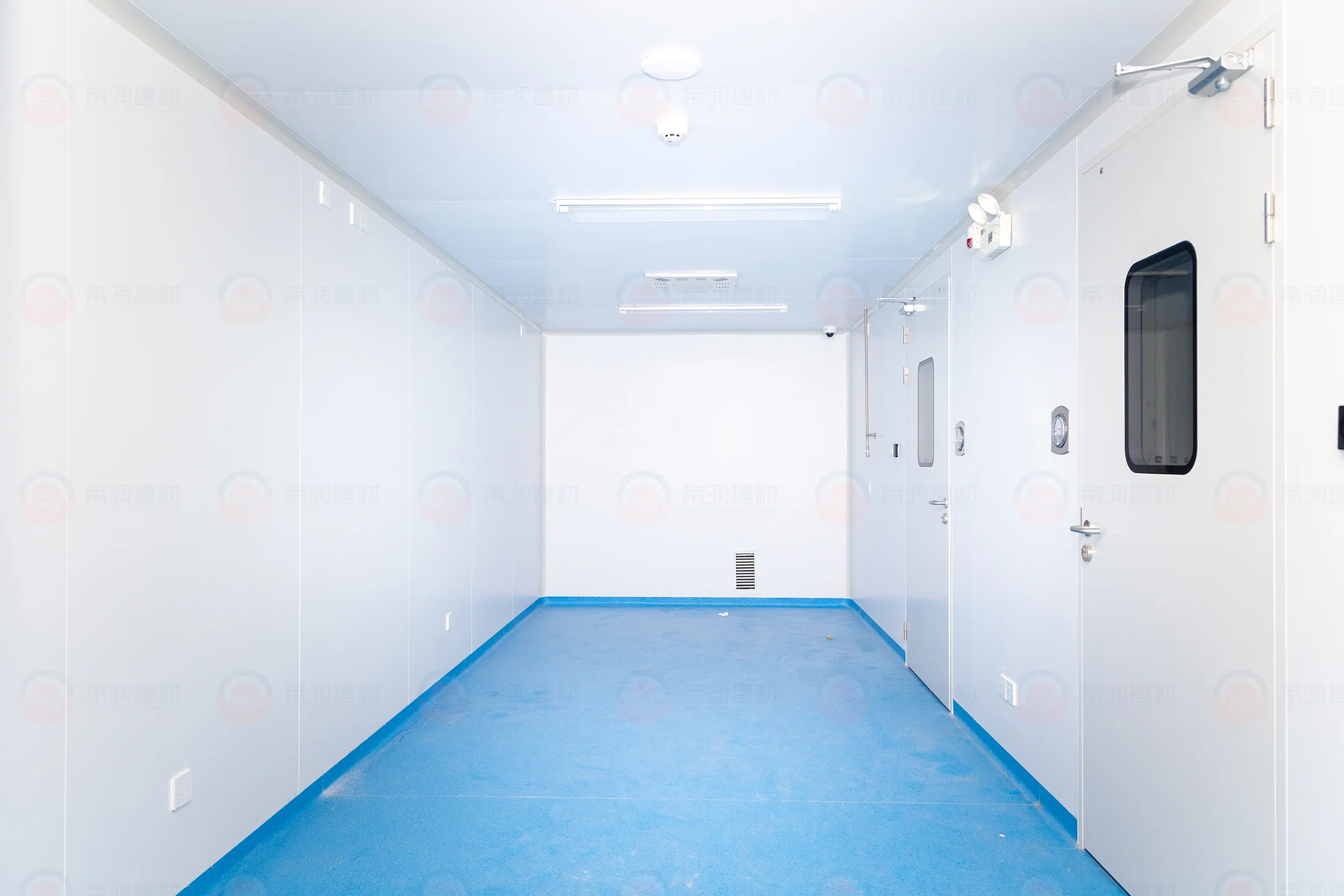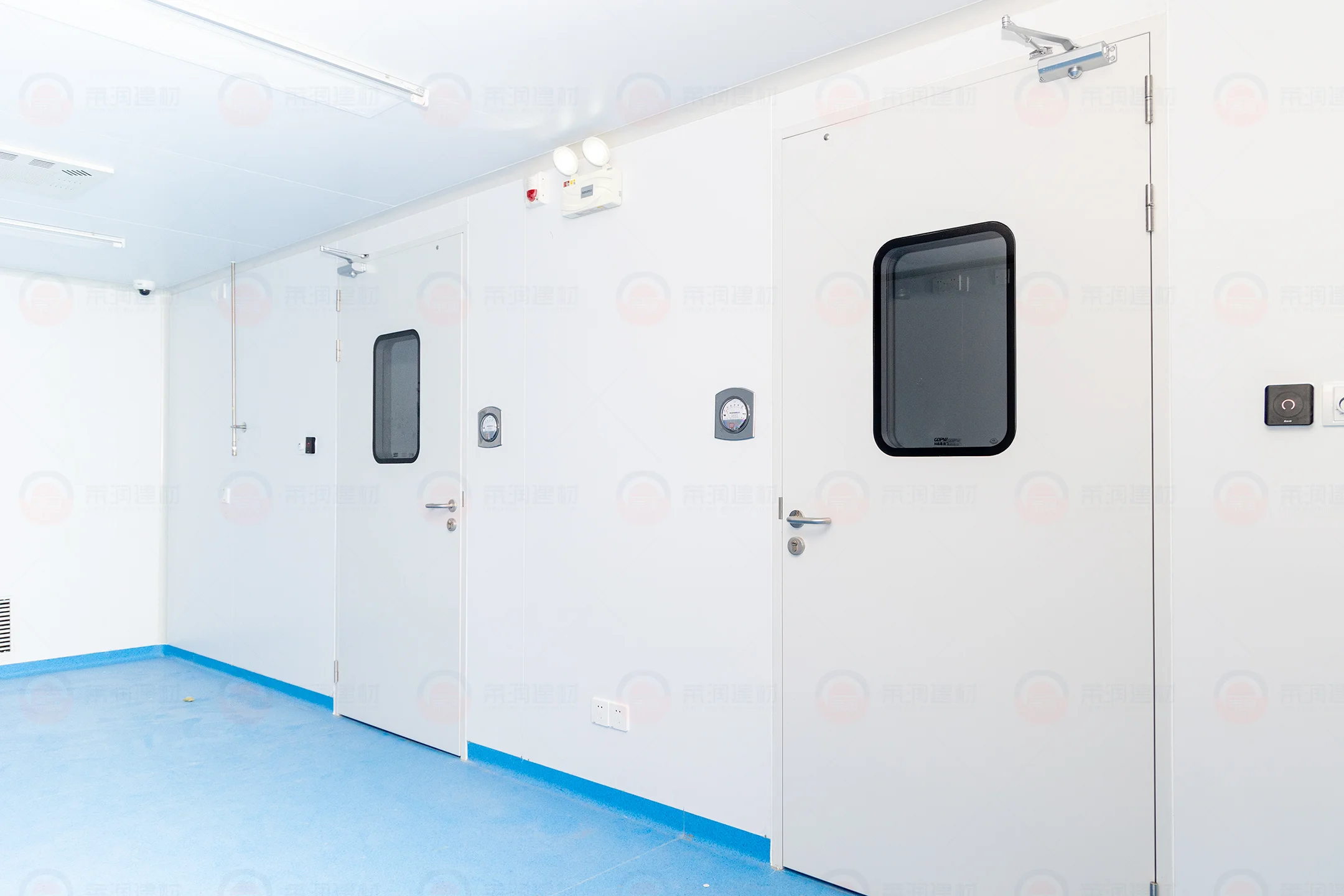วิธีการรับประกันการปฏิบัติตามในการออกแบบสภาพแวดล้อมที่ไม่ฆ่าเชื้อ
เวลา : 05 มิถุนายน 2025 ผู้เข้าชม : 1762
การสร้างพื้นที่ที่สะอาด และปราศจากเชื้อโรค เป็นสิ่งสำคัญมากสําหรับอุตสาหกรรม เช่น การแพทย์ เทคโนโลยีชีวภาพ และการผลิตอาหาร คู่มือนี้ให้คำแนะนำง่ายและมือสำหรับการสร้างและรักษาสภาพแวดล้อมที่ปลอดภัยและปฏิบัติตามกฎ เราจะครอบคลุมปัจจัยใหญ่ เช่น การเก็บวัสดุ การจัดการกับการไหลของอากาศ และการหยุดเชื้อโรค นอกจากนี้, เราจะสปอตไลท์ LAIRUNผลิตภัณฑ์ที่น่ากลัวที่ตอบสนองมาตรฐานทั่วโลกที่เข้มงวดสําหรับการสร้างและบำรุงรักษาห้องสะอาด

หลักการสำคัญในการออกแบบสภาพแวดล้อมที่ไม่ฆ่าเชื้อ
ความต้องการสําหรับสภาพแวดล้อมที่ไม่ฆ่าเชื้อคืออะไร?
เพื่อให้พื้นที่สะอาด คุณต้องบล็อกเชื้อโรค สภาพแวดล้อมที่ไม่ฆ่าเชื้อ สำคัญมากในสถานที่ เช่น โรงงานยา หรือโรงงานอาหาร ที่การสะอาดจะหยุดการปนเปื้อน คุณต้องการพื้นผิวที่แบนและไม่มีรูพรุน ที่ช่วยให้เชื้อโรคไม่ติด และง่ายต่อการขัด นอกจากนี้ เครื่องกรองอากาศที่มีประสิทธิภาพยังเป็นกุญแจในการรักษาอากาศบริสุทธิ์ และแนะนำการไหลของมัน
มาตรฐานกฎหมายอะไรที่ควบคุมการออกแบบห้องที่ไม่ฆ่าเชื้อ?
การยึดมั่นในกฎเป็นสิ่งจำเป็นสำหรับ ห้องสะอาด การตั้งค่า แนวทางจากกลุ่มเช่น ISO, WHO และ FDA กําหนดมาตรฐานที่ชัดเจน ตัวอย่างเช่น ISO 14644 จัดห้องสะอาดโดยมีบิตเล็ก ๆ ที่ลอยอยู่ในอากาศ กฎเหล่านี้ทําให้แน่ใจว่าพื้นที่จะปราศจากเชื้อโรคและปลอดภัย
ทำไมการประเมินความเสี่ยงจึงเป็นสิ่งสำคัญในการออกแบบยาฆ่าเชื้อ?
การค้นหาความเสี่ยง เป็นสิ่งสำคัญจริงๆ โดยการค้นหาแหล่งเชื้อโรคที่อาจเกิดขึ้น เช่น เครื่องมือ คนงาน หรืองาน คุณสามารถดําเนินการเพื่อหยุดมัน การวางแผนที่ฉลาดนี้ทําให้พื้นที่ปลอดภัย ปฏิบัติตามกฎ และทําให้งานดําเนินการได้อย่างราบรื่น
การพิจารณาทางโครงสร้างและวัสดุ
การเลือกสิ่งที่เหมาะสมที่จะสร้างด้วย เป็นกุญแจในการรักษาห้องสะอาด ส่วนนี้อธิบายคุณสมบัติที่ดีที่สุดสําหรับผนัง เพดาน และพื้น เพื่อรับประกันความสะอาดและการควบคุมเชื้อโรคที่ดี
คุณเลือกวัสดุก่อสร้างสําหรับห้องที่ไม่ฆ่าเชื้ออย่างไร?
พื้นผิวที่ไม่มีรูพรุนและทำความสะอาดได้ง่าย
สิ่งที่คุณเลือกทำให้มีความแตกต่างมาก พื้นผิวที่ไม่มีรูพรุนหยุดให้เชื้อโรคซ่อนหรือเติบโต ตัวอย่างเช่น สแตนเลสหรือพลาสติกที่แข็งแรงเป็นตัวเลือกที่ดี เพราะมันแข็งแรงและง่ายต่อการเช็ด
วัสดุทนต่อการป้องกันการมลพิษ
วัสดุต้องจัดการของเหลวทําความสะอาดโดยไม่สวมใส่ แผงแมกนีเซียมออกซิซัลไฟด์เป็นตัวเลือกที่น่ากลัว พวกเขาต่อสู้กับไฟ ยังความร้อน หยุดเชื้อโรค และไม่ดูดน้ำ นอกจากนี้ พวกเขาปลอดภัยและไม่ปล่อยสิ่งที่ไม่ดี ซึ่งทําให้พวกเขาดีสำหรับห้องสะอาดชั้นนำ
ผนัง, เพดาน, และพื้นควรมีคุณสมบัติอะไร?
ผนังควรมีรอยต่อแน่น เพื่อหยุดฝุ่นจะสะสมขึ้น เพดานมักจะใช้แผงพิเศษที่ดูดีและทำงานได้ดี ด้วยวัสดุที่เลือกตามความต้องการบางอย่าง พื้นต้องแข็งแกร่งสำหรับการเดินจำนวนมาก แต่ยังง่ายต่อการทำความสะอาด
ระบบการไหลของอากาศและการระบายอากาศในสภาพแวดล้อมที่ไม่มีการฆ่าเชื้อ
ทำไมตัวกรอง HEPA เป็นสิ่งสำคัญ?
ตัวกรอง HEPA มีความสำคัญมาก พวกเขาจับชิ้นเล็ก ๆ ที่เล็กเท่า 0.3 ไมครอน ด้วยความสำเร็จ 99.97% นี่จะทำให้แน่ใจว่า อากาศสะอาดเท่านั้น จะเคลื่อนไหวผ่านห้อง
คุณออกแบบรูปแบบการไหลของอากาศที่มีประสิทธิภาพอย่างไร?
การไหลของอากาศที่ดีช่วยให้เชื้อโรคไม่แพร่กระจาย ระบบการไหลลามิเนอร์ส่งอากาศไปในทิศทางเดียวด้วยความเร็วที่คงที่ นี่สร้างโล่รอบจุดสำคัญ ทําให้มันสะอาดมาก
ระบบการติดตามและควบคุมสิ่งแวดล้อม
ทำไมการติดตามในเวลาจริงมีความสำคัญ?
การดูแลสิ่งแวดล้อมตลอดเวลาเป็นสิ่งจำเป็น เครื่องมือแบบเรียลไทม์ตรวจสอบการติดตามทางโภชนาการ เช่น นับอนุภาค อุณหภูมิ และระดับความชื้น ข้อมูลนี้ช่วยให้แน่ใจว่าพื้นที่จะปฏิบัติตามกฎที่เข้มงวด
ระบบติดตามนับอนุภาค
เครื่องมือที่ฉลาดจับชิ้นส่วนเล็ก ๆ ในอากาศก่อน นี่ช่วยให้คุณแก้ไขปัญหาก่อนที่มันจะใหญ่ขึ้น
กลไกการควบคุมอุณหภูมิและความชื้น
อุณหภูมิและความชื้นเปลี่ยนแปลงวิธีการเติบโตอย่างรวดเร็ว ดังนั้น การควบคุมที่แม่นยำจําเป็นต้อง เพื่อให้สิ่งต่างๆ ถูกต้อง
การอัตโนมัติช่วยเพิ่มสภาพแวดล้อมที่ไม่ปลอดเชื้อได้อย่างไร?
การใช้เทคโนโลยีที่ฉลาด ทําให้การดูสิ่งแวดล้อมง่ายขึ้น เครื่องมืออัตโนมัติลดความผิดพลาดของมนุษย์ ซึ่งลดความเสี่ยงจากเชื้อโรค พวกเขายังใช้ข้อมูลเพื่อจับและแก้ไขปัญหา ทําให้พื้นที่ทํางานดีขึ้น
การออกแบบอุปกรณ์และเฟอร์นิเจอร์เพื่อการปฏิบัติตามกฎหมาย
เกณฑ์ใดควรแนะนําการเลือกอุปกรณ์ในห้องที่ไม่ฆ่าเชื้อ?
เมื่อเลือกอุปกรณ์ ให้มุ่งเน้นการหยุดเชื้อโรค เลือกเครื่องมือที่มีพื้นผิวเรียบและไม่มีรูพรุนเพื่อปิดกั้นการเติบโตของเชื้อราและทำให้การทำความสะอาดง่าย สแตนเลสเป็นตัวเลือกที่ดีเพราะมันแข็งและจัดการของเหลวทําความสะอาดได้ดี นอกจากนี้ อุปกรณ์ควรมีขนาดเล็ก และออกแบบมาเพื่อประหยัดพื้นที่ในขณะที่สะอาด
อุปกรณ์ต้องปฏิบัติตามกฎเช่น ISO 14644 กรองอากาศในตัวช่วยให้การไหลของอากาศสะอาดและตัดอนุภาค การออกแบบแบบโมดูลเป็นที่น่ากลัวเช่นกัน - พวกเขาง่ายต่อการแยกออกและทำความสะอาด ซึ่งเป็นสิ่งสำคัญในการรักษาสิ่งต่างๆ ที่ปราศจากเชื้อโรค
การออกแบบเฟอร์นิเจอร์แบบ Ergonomic สามารถลดความเสี่ยงของมลพิษได้อย่างไร?
เฟอร์นิเจอร์ที่ใช้งานง่ายช่วยให้สิ่งที่สะอาด เก้าอี้โต๊ะ และสถานีทํางานควรมีขอบกลม และไม่มีช่องว่างที่ฝุ่นหรือจุลินทรียะซ่อนอยู่ วัสดุเช่นพลาสติกที่แข็งแรงหรือโลหะเคลือบยืนต่อสินค้าทําความสะอาด
เฟอร์นิเจอร์ที่ปรับได้ช่วยให้คนงานอยู่สะดวกสบายโดยไม่เคลื่อนย้ายมาก ซึ่งสามารถเตะเชื้อโรค วัสดุป้องกันไฟฟ้าสถิตยังช่วยให้ฝุ่นจากติดกับพื้นผิว
การปฏิบัติบุคลากรและการปรับปรุงการกระแสการทำงาน
การไหลของบุคลากรควรออกแบบอย่างไรเพื่อลดการมลพิษ?
การวางแผนวิธีการที่คนเคลื่อนไหว เป็นกุญแจในการป้องกันจุลินทรีย์ ตั้งโซนที่ชัดเจนสำหรับพื้นที่ที่สะอาดและสะอาดน้อยกว่า ด้วยล็อคอากาศหรือจุดบัฟเฟอร์ แนะนําพนักงานจากพื้นที่ที่สะอาดน้อยไปยังพื้นที่ที่สะอาดซุปเปอร์ โดยไม่หันกลับ
พื้นที่ใส่ชุดเป็นขั้นตอนแรกที่จะหยุดเชื้อโรค จุดเหล่านี้ต้องการพื้นที่แยกต่างหากสำหรับการใส่และถอดเสื้อผ้าป้องกัน ป้ายที่ชัดเจนควรแสดงแต่ละขั้นตอน เริ่มต้นด้วยสถานีล้างมือ จากนั้นพื้นที่เสื้อผ้าควรมีเสื้อผ้าปราศจากเชื้อโรคที่เก็บไว้ในกล่องปิด
โปรแกรมอบรมจะรับประกันการบำรุงรักษาตามกฎหมายได้อย่างไร?
การฝึกอบรมช่วยให้พนักงานพร้อมที่จะปฏิบัติตามกฎ การเรียนเป็นประจําสอนการแต่งกายที่เหมาะสม การจัดการเครื่องมือที่ปลอดภัย และขั้นตอนสุขอนามัย ฝึกฝนเตรียมพนักงานสำหรับฉุกเฉินในขณะที่รักษาสิ่งที่ปราศจากเชื้อโรค
การฝึกอบรมยังควรแสดงให้พนักงานเห็นวิธีการเคลื่อนที่น้อยลงในห้องสะอาดเพื่อหลีกเลี่ยงการกระตุ้นอนุภาค การใช้ข้อมูลในเวลาจริงในการฝึกอบรมช่วยให้คนงานเห็นว่าการกระทําของพวกเขามีผลต่อพื้นที่อย่างไร
คําแนะนําเกี่ยวกับผลิตภัณฑ์ LAIRUN สําหรับการออกแบบสิ่งแวดล้อมที่ไม่ฆ่าเชื้อ
LAIRUN มีสิ่งที่เสนอสําหรับการใช้งานที่ไม่ฆ่าเชื้อ?
LAIRUN ให้ ผลิตภัณฑ์คุณภาพสูง สำหรับพื้นที่สะอาด แผงแซนวิชของพวกเขาใช้วัสดุหลักที่แข็งแกร่ง เช่น แมกนีเซียมออกซิซัลไฟด์ และขนหิน เหล่านี้ให้ความต้านทานไฟที่ดี ฉนวนความร้อน และพลังต่อต้านเชื้อโรค พวกเขายังต้านทานน้ำ และตอบสนองมาตรฐานโลกที่เข้มงวด เหมาะสำหรับอุตสาหกรรมยา เทคโนโลยีชีวภาพ และอาหาร

อะไรทําให้ระบบการกรองอากาศของพวกเขาโดดเด่น?
ระบบการกรองอากาศของ LAIRUN ใช้กรอง HEPA ที่มีเทคโนโลยีสูง เหล่านี้จับอนุภาคขนาดเล็กเท่า 0.3 ไมครอน ด้วยประสิทธิภาพ 99.97% ให้อากาศสะอาดมาก ระบบผสมผสานอย่างดีกับห้องสะอาด และรักษาการไหลของอากาศให้มั่นคง เพื่อหยุดการแพร่กระจายของเชื้อโรค
ทำไมต้องเลือกโซลูชั่นห้องสะอาดแบบโมดูล?
ห้องสะอาดแบบโมดูลอร์มีความยืดหยุ่นและรักษาความฆ่าเชื้อสูง การออกแบบของ LAIRUN สามารถติดตั้งได้อย่างรวดเร็ว และเปลี่ยนแปลงได้ง่ายตามความต้องการเปลี่ยนแปลง แผงของพวกเขาใช้การเชื่อมต่อลิ้นและร่องที่แน่น ลดเวลาการตั้งค่าถึง 50%
ประโยชน์ของการใช้ผลิตภัณฑ์ LAIRUN คืออะไร?
ผลิตภัณฑ์ LAIRUN ช่วยตอบสนองกฎด้วยวัสดุคุณภาพสูงที่ทำสําหรับห้องสะอาด แผงแมกนีเซียมออกซิซัลไฟด์ของพวกเขาเป็นมาตรฐานอุตสาหกรรมสูงสุด ด้วยความต้านทานไฟ ฉนวนเสียง และคุณสมบัติที่เป็นมิตรก นอกจากนี้ ตัวเลือกที่สามารถปรับแต่งได้ช่วยให้คุณจับคู่ผลิตภัณฑ์กับความต้องการของโครงการของคุณ
คำถามที่พบบ่อย
Q1: ทำไมการออกแบบเฟอร์นิเจอร์ที่ไม่มีรอยต่อสําคัญในห้องที่ไม่มีชีวิต?
ตอบ: เฟอร์นิเจอร์ที่ไม่มีรอยต่อหยุดฝุ่นหรือจุลินทรียะจากการรวบรวมในรอยแตกทำให้พื้นที่สะอาดและปลอดภัยขึ้น
Q2: โซลูชั่นห้องสะอาดแบบโมดูลเป็นประโยชน์จากความยืดหยุ่นในการดำเนินงานอย่างไร?
ตอบ: การออกแบบแบบโมดูลอร์ช่วยให้การติดตั้งอย่างรวดเร็วและการเปลี่ยนแปลงง่ายในขณะที่รักษาความเป็นฆ่าเชื้อปรับตัวเข้ากับความ
Q3: ทำไมแมกนีเซียมออกซิซัลไฟด์เป็นวัสดุหลักที่เหมาะสำหรับแผงห้องสะอาด?
ตอบ: แมกนีเซียมออกซิซัลไฟด์ต่อสู้กับไฟฉนวนความร้อนหยุดเชื้อโรคและไม่ดูดน้ำทำให้สมบูรณ์แบบสำหรับห้องสะอาดระดับสูง






